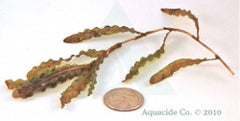
Curly Leaf Pondweed is a perennial weed that is native to Europe. It escaped into American waters in the late 19
Curly Leaf Pondweed has a unique life cycle. In early spring, Curly Leaf Pondweed is one of the first weeds to appear and will die back by mid-July.
Curly Leaf Pondweed grows rapidly. This rapid growth may crowd native growth and reduce recreational activities like fishing, swimming and boating. These limitations may also reduce real estate values.
4 control methods:
1) Mechanical:
Hand pulling is intensive and time consuming. Cutting at the base can prevent
2) Biological:
Grass carp will consume Curly Leaf Pondweed. Recommended stocking rates are 7-15 fish per surface acre. Results seldom appear until the second season.
3) Chemical:
4) Drawdown:
This is an effective option for small areas including swimming beaches and around docks.
5) Barriers will block sunlight that weeds need to grow. This option will have to be anchored and routinely maintained and may have a negative impact on trapped organisms below the barrier.
Prevention is an ideal way to prevent spread of Curly Leaf Pondweed. Be sure to clean your boat and trailer of any weed growth before launching or removing your boat from any water body.
Read what our customers have to say about our products:
Review for Hydrothol Granular
“Works Great!."
- Kurt S
